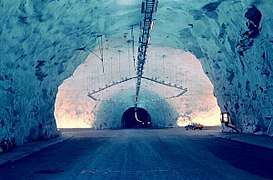Lærdal Tunnel
The Lærdal Tunnel (Norwegian: Lærdalstunnelen) is a 24.51-kilometre-long (15.23 mi) long road tunnel connecting the municipalities of Lærdal and Aurland in Vestland county, Norway, and located approximately 175–200 kilometres (109–124 mi) north-east of the city of Bergen. It is the longest road tunnel in the world, succeeding the Swiss Gotthard Road Tunnel. The tunnel carries two lanes of European Route E16 and represents the final link on the new main highway connecting Oslo and Bergen without ferry connections and difficult mountain crossings during winter.
| Overview | |
|---|---|
| Location | Vestland, Norway |
| Coordinates | 60°58′19″N 07°22′06″E |
| Route | E16 |
| Operation | |
| Work begun | 1995 |
| Opened | 2000 |
| Operator | Norwegian Public Roads Administration |
| Character | Road |
| Toll | no |
| Vehicles per day | 2,050 (2019)[1] |
| Technical | |
| Length | 24.51 km (15.23 mi) |
| Operating speed | 80[2] |
| Highest elevation | 265 m (869 ft) |
| Lowest elevation | 5 m (16 ft) |
| Width | 9 m (30 ft) |
| Grade | 2.5% |
In 1975, the Parliament of Norway decided that the main road between Oslo and Bergen would run via Filefjell. In 1992, Parliament confirmed that decision, made the further decision that the road should run through a tunnel between Lærdal and Aurland, and passed legislation to build the tunnel. Construction started in 1995 and the tunnel opened in 2000. It cost 1.082 billion Norwegian krone ($113.1M USD).[3][4]
Design
A total of 2,500,000 cubic metres (3,300,000 cu yd) of rock was removed from the tunnel during its construction from 1995 to 2000. The tunnel begins just east of Aurlandsvangen in Aurland and goes through a mountain range and ends 5.5 kilometres (3.4 mi) south of Lærdalsøyri in Lærdal. The design of the tunnel takes into consideration the mental strain on drivers, so the tunnel is divided into four sections, separated by three large mountain caves at 6-kilometre (3.7 mi) intervals. While the main tunnel has white lights, the caves have blue lighting with yellow lights at the fringes to give an impression of sunrise. The caves are meant to break the routine, providing a refreshing view and allowing drivers to take a short rest. The caverns are also used as turnaround points and for break areas to help lift claustrophobia during a 20-minute drive through the tunnel.[3] In the tunnel, there is a sign on every kilometer indicating how many kilometers have already been covered, and also how many kilometers there are still to go. To keep drivers from being inattentive or falling asleep, each lane is supplied with a loud rumble strip towards the centre.[5]
Safety
The tunnel does not have emergency exits. In case of accidents and/or fire, many safety precautions have been made. There are emergency phones marked "SOS" every 250 metres (820 ft) which can contact the police, fire departments, and hospitals. Fire extinguishers have been placed every 125 metres (410 ft). Whenever an emergency phone in the tunnel is used or a fire extinguisher is lifted, stop lights and electronic signs reading: snu og køyr ut (English: turn and exit) are displayed throughout the tunnel and 2 other electronic signs on both sides of the entrance reading: tunnelen stengt (English: Tunnel closed). There are 15 turning areas which were constructed for buses and semi-trailers. In addition to the three large caverns, emergency niches have been built every 500 metres (1,600 ft). There are photo inspections and counting of all vehicles that enter and exit the tunnel at security centres in Lærdal and Bergen. There is also special wiring in the tunnel for the use of radio and mobile phones.[4][5] Speed cameras have been installed because of serious speeding (there are very few other completely straight roads in the region).
Air quality
High air quality in the tunnel is achieved in two ways: ventilation and purification. Large fans draw air in from both entrances, and polluted air is expelled through the ventilation tunnel to Tynjadalen. The Lærdal Tunnel is the first in the world to be equipped with an air treatment plant, located in a 100-metre (330 ft) wide cavern about 9.5 kilometres (5.9 mi) northwest of Aurlandsvangen. The plant removes both dust and nitrogen dioxide from the tunnel air. Two large fans draw air through the treatment plant, where dust and soot are removed by an electrostatic filter. Then the air is drawn through a large carbon filter, which removes the nitrogen dioxide.[5]
See also
- Yamate Tunnel
- Inje-Yangyang Tunnel
Media gallery
- A car parked in one of the tunnel caves
 View of one of the caves
View of one of the caves One of the Lærdalstunnel caves has blue lighting with yellow lights
One of the Lærdalstunnel caves has blue lighting with yellow lights- North portal
 South portal
South portal
References
- https://www.vegvesen.no/vegkart Zoom in and search for "Trafikkmengde")
- https://www.vegvesen.no/vegkart Zoom in and search for "Fartsgrense")
- "Norway opens world's longest road tunnel". CNN. November 2000. Retrieved 2008-01-08.
- "Lærdal Tunnel". Engineering.com. Retrieved 2010-09-06.
- Brekke, Arne. "The world's longest road tunnel: Lærdal - Aurland". Bergen Guide. Retrieved 2010-09-06.
External links
| Wikimedia Commons has media related to Lærdalstunnelen. |
| Records | ||
|---|---|---|
| Preceded by Gotthard Road Tunnel 16.4 km (10.2 mi) |
World's longest road tunnel 2000–present |
Incumbent |